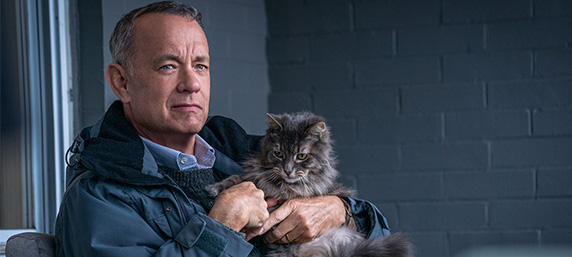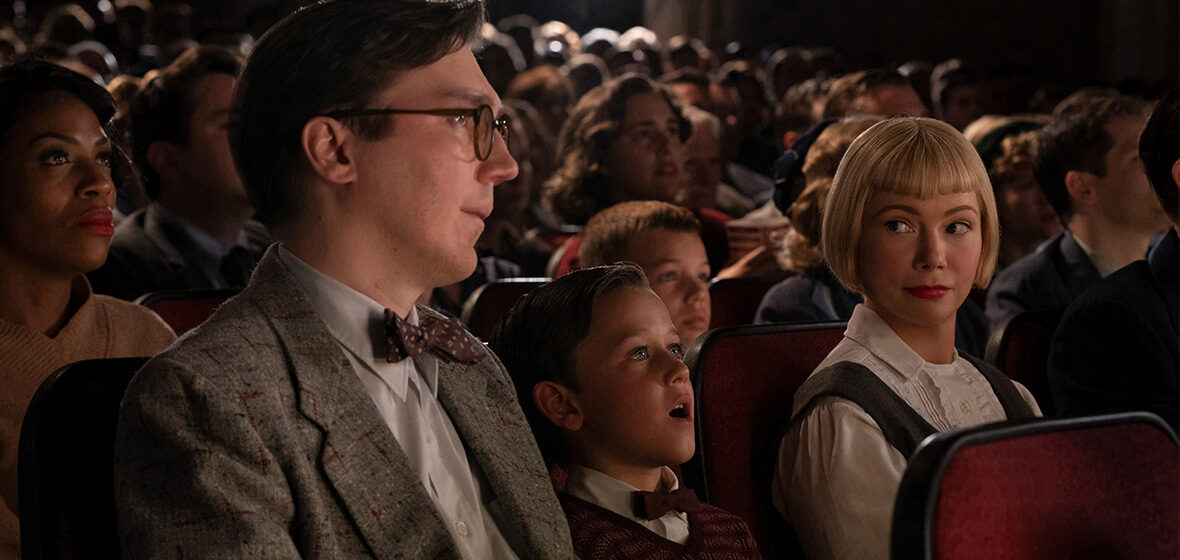The Fabelmans
“What makes an artist an artist?” is an age-old and very pedestrian question. And it’s unanswerable. There’s no one grand truth about life, and, honestly, asking the question serves only to reflect our own insecurities: our sense that if only we had had the same revelation as the artist did when he was five, we could have been just as successful. That’s not interesting. Amadeus is great because of that thumping realisation that genius exists in the world, and we just have to live with that.
In The Fabelmans, Sammy Fabelman (first played by Mateo Zoryan and later by Gabriel LaBelle) finds his artistic calling the moment his parents, Burt and Mitsy (Adam Driver and Michelle Williams, respectively), take him to see Cecil B. DeMille’s The Greatest Show On Earth. What grabs young Sammy is not the emotional and tragic romance between two trapeze artists, but the moment the circus train crashes against an automobile. Unlike the story’s emotional heart, it is the spectacle that has an effect on the young, impressionable Sammy.
Sammy IS Steven Spielberg. If you’ve ever read an article about the filmmaker, you’ll probably recognise some of the stories and anecdotes in The Fabelmans. There are also moments with visual cues that directly reference some of his films – for example, a shot taken from the beginning of Indiana Jones and the Last Crusade. And another that could’ve been from Empire of the Sun. With the help of writer Tony Kushner, Spielberg structures his memories to give sense to his life. The line between what’s real and what’s pure dramatisation is purposely blurred, because Spielberg’s statement is, “this is how I see myself”.
Is self-reflection the responsibility of an artist? The Fablemans is not an autobiography, but is as close to reality as possible. In each episode, Sammy learns something important about life that he can repurpose as an emotional motif from one of his home movies. As in the scene where Sammy films his mother dancing in a see-through dress in front of his father and family friend Benny (Seth Rogen). In this strange feverish sequence with so apparent a Freudian tone it’s hard to find any subtlety.
Spielberg still finds time and place in the film to explore some of his insecurities. The big climax is a curious choice that says more about the director’s anxieties than anything else. He learns how different people will react differently to his work, in this case a montage of his class during a school trip to the beach. Most colleagues will see it as pure entertainment. For the bully of the class, it will be an embarrassment. And for the jock, portrayed as an all-American white hero, it’s a look he struggles to accept. Spielberg/Sammy realises that his talent can create a distorted reality, a whitewashed world, one that doesn’t reflect the truth. It’s the realisation that the American Dream is a Hollywood fabrication. Spielberg would become the standard of the cultural hegemony in Reagan’s America. Part of the shiny city up on the hills was built on the concepts that he and his colleague filmmakers from the 80s developed. It’s a bleak thought, but Spielberg reveals another side of this philosophy – that up until now, the weak nerdy Jewish boy could not tell the stories about his life.
The Fabelmans is a beautiful film. Is it narcissistic? Maybe, but a filmmaker like Spielberg earned the right to this indulgence. Some critics didn’t get Dano’s and Williams’ casting as the parents, and I can see why. Dano, perpetually young-faced with a creaky voice, doesn’t warrant authority. And Williams, also young and ethereal, doesn’t fit our idea of a mature and responsible parent. But I think this depiction is deliberate: this is how a child idealises his parents, seeing them as youthful, approachable, and reliable.
The film ends with a great visual gag that shatters the fourth wall to remind us that this is where Spielberg’s journey started. It’s at the end of an anecdote about meeting John Ford (hilariously played by David Lynch), and is punctuated with the type of visual gag that Michel Hazanavicius would have loved to have included in one of his films. It’s funny because Spielberg was never one for that kind of meta-commentary. Still, after dwelling so long in his own memories, in the end he lets himself wink at the audience. The Fabelmans may not be his last film, but if his career stops here, it’s an excellent last paragraph.
Verdict: 4 out of 5
For those who still regard Spielberg as the standard for blockbuster quality, and good-hearted nostalgia seekers.

A Man Called Otto
As well as Hollywood knows how to weaponise nostalgia, it also still excels at weaponising grief.
In A Man Called Otto, Tom Hanks plays the grumpy titular character who contemplates ending his life after being forced into retirement. Otto is unpleasant to his co-workers and neighbours, though everyone is friendly enough. They just accept his grumpiness as part of his quirkiness: “Oh, that’s Otto being a grinch”.
A couple of things happen to Otto. First, a new family, including the sprite-like and happy-go-lucky Marisol (Mariana Treviño) moves next door and unintentionally interrupts Otto’s attempts to end his life. Then a stray cat encroaches on his life, and the usually isolated man suddenly finds himself around more company than expected. Finally, a prominent local corporation is trying to buy out the homeowners in the area so they can build large apartment units. It wouldn’t be a problem for good ol’ Otto if he’s not thinking of hanging around for much longer, but the proposed development affects two of his neighbours whom he still cares for though he is estranged from them. You see, underneath the unfriendly façade, Otto actually has a big heart, as literally indicated by the fact that he has a condition characterised by a larger than average heart. It’s not the lack of subtlety that bothers me here, but that the symbolism is unsubtle to the point of being offensive.
A Man Called Otto is a sapfest of worn sentimentality that never feels genuine. Little in it does. It includes an anti-corporation message that doesn’t go past the basic notions, and it’s contrasted with Otto’s obsession with Chevrolets (talk about big corporations who destroyed communities of hard-working Americans). It includes an immigrant family, an African-American family, and a trans character whose whole personality is “being trans”. And yet it doesn’t develop any social and political issues surrounding any of those characters.
The film is based on a successful Swedish novel, A Man Called Ove, known for its unbearable and unrelenting sadness, missing in the American adaptation. Hanks, who also produces the film, has too much of a friendly persona to convince us that Otto is nothing but a generically grumpy character. He tries his best to do a Clint Eastwood impersonation. But still he’s Tom Hanks – despite his ability to display a wide range of emotions, there’s a delicacy in convincingly showing irritation. Any actor whose career revolves around being the friendliest man in the room will struggle to achieve that.
Because, of course, that’s what happens. The film shows how Otto learns to care – even though he never stopped caring, really. So, in reality, we observe that he just knows to lighten up and smile every once in a while. And there must be more than for a film to rely on for its big emotional arc.
Marc Forster, who directed the film from a script by his usual collaborator David Magee, is the kind of competent director with successful film making well studied. He’s not interested in wallowing in Otto’s sadness if he can’t find some light-heartedness there. So Forster recruits Thomas Newman to write the score, which lends an odd charm to a potential suicide scene. Newman’s quirky plinky-plonks would fit perfectly in a Pixar movie (Newman scored a few of these) or in the darkly funny Six Feet Under (whose theme tune he also composed). Still, here it feels at odds with the subject matter.
Most egregiously, the film succumbs to a couple of corny needle drops that cheapen some of its bigger dramatic turns. A case in point is a series of flashbacks that show Otto’s relationship with his wife – we see how the two met, how they fell in love, and how it all tragically ended. This is unnecessary, as Forster manages to add context with intelligent mise-en-scénes (like a colourful jacket in Otto’s house or his oven being lower than average). But the big emotional revelation is punctuated by Kate Bush’s This Woman’s Work, a baffling and almost crass choice that seems half to half misunderstand the original song and completely to miss the point of the scene it’s trying to portray.
A Man Called Otto is strangely ordinary. It works too hard at manipulating our emotions, with intentions that don’t seem genuine. This film fails to take advantage of its source material, and instead tries to appeal to the lowest common denominator.
Verdict: 2 out of 5
For the biggest Tom Hanks fans and people ready for a bit of a cry in the cinema. Definitely not for the fans of the original book.




